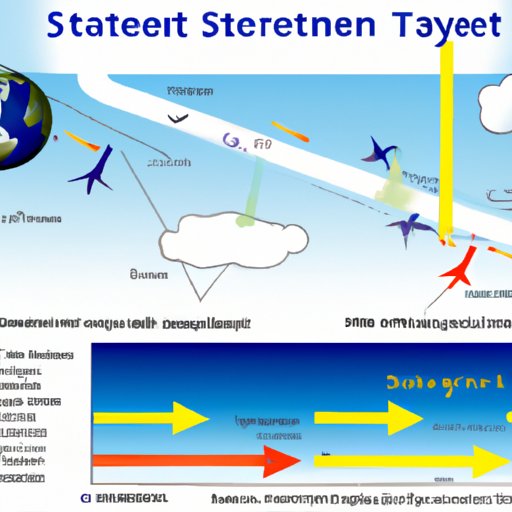Introduction
Air science is a field of study that examines the composition, pollution, and weather patterns of our atmosphere. It is an interdisciplinary subject that draws from physics, chemistry, meteorology, and other sciences in order to gain a better understanding of the processes at work in the atmosphere. Through research and observation, air science seeks to uncover the causes and effects of atmospheric phenomena, as well as their potential impacts on the environment and human health.

Exploring the Science Behind Air and Its Composition
Air is composed of several gases, including nitrogen (78%), oxygen (21%), and trace amounts of other gases such as argon, carbon dioxide, and ozone. Nitrogen is a colorless, odorless gas that is essential for many biological processes. Oxygen is also essential for life, and it is used by cells to produce energy through respiration. Other trace gases play important roles in shaping Earth’s climate, such as carbon dioxide, which traps heat and helps regulate global temperatures.

How Air Pollution Impacts Our Environment
Air pollution is a major environmental concern, as it can have serious consequences for human health, ecosystems, and climate. Sources of air pollution include burning fossil fuels for transportation and energy production, industrial emissions, and agricultural activities. According to the World Health Organization, air pollution is linked to an estimated 7 million deaths each year. It can also cause respiratory illnesses, heart disease, and cancer, as well as damage to crops, forests, and aquatic ecosystems. Long-term exposure to air pollution has been linked to climate change, as pollutants like carbon dioxide trap heat in the atmosphere and contribute to global warming.
The Role of Wind in Weather Patterns
Wind is an important factor in shaping Earth’s climate and weather patterns. It is created when air pressure differences between two locations cause air to move from higher pressure to lower pressure. As wind moves across the planet, it affects temperature, humidity, and precipitation levels. For example, warm, moist air flows from the tropics towards the poles, while cold, dry air flows from the poles towards the tropics. These air movements help form the jet streams, which are large bands of fast-moving air that influence global weather systems.
Investigating the Effects of Greenhouse Gases on Climate Change
Greenhouse gases are gases in the atmosphere that trap heat and contribute to global warming. The most abundant greenhouse gas is carbon dioxide, which is released when fossil fuels are burned for energy or transportation. Other greenhouse gases include methane, nitrous oxide, and chlorofluorocarbons (CFCs). According to the Intergovernmental Panel on Climate Change (IPCC), human activities, such as burning fossil fuels and deforestation, are responsible for a 1.5°C increase in global temperatures since pre-industrial times.

Understanding the Impact of Jet Streams on Global Weather
Jet streams are high-altitude winds that flow around the globe, usually near the boundaries between warmer and colder air masses. They are responsible for steering storms and influencing weather patterns, such as the formation of El Niño and La Niña events. Jet streams can also affect temperatures, as they can transport warm or cold air across long distances. By studying the behavior of jet streams, scientists can better understand how global weather patterns are formed and affected.
Examining the Benefits of Atmospheric Pressure
Atmospheric pressure is the force exerted by air molecules on the surface of the Earth. It is one of the most important factors in controlling temperature, winds, and weather patterns. High-pressure systems are associated with clear skies, while low-pressure systems are associated with stormy weather. By studying atmospheric pressure, scientists can better predict weather patterns and their potential impacts on the environment.
Studying the Interaction of Ozone, Water Vapor, and Radiation
Ozone is a molecule composed of three oxygen atoms that occurs naturally in the stratosphere. It plays an important role in protecting the planet from harmful ultraviolet radiation from the sun. However, when ozone is present in the lower atmosphere, it can be a pollutant and can cause respiratory illnesses. Water vapor is another important component of the atmosphere, as it absorbs and releases heat energy and helps regulate Earth’s climate. By studying the interactions of ozone, water vapor, and radiation, scientists can better understand how these components interact to affect the climate.
Conclusion
This article explored the science behind air and its composition, pollution, and weather patterns. We discussed the chemical composition of air, the sources of air pollution, the role of wind in weather patterns, the effects of greenhouse gases on climate change, and the interaction of ozone, water vapor, and radiation. Air science is an important field of study that helps us gain a better understanding of the processes at work in the atmosphere and their impacts on our environment and human health.
(Note: Is this article not meeting your expectations? Do you have knowledge or insights to share? Unlock new opportunities and expand your reach by joining our authors team. Click Registration to join us and share your expertise with our readers.)
